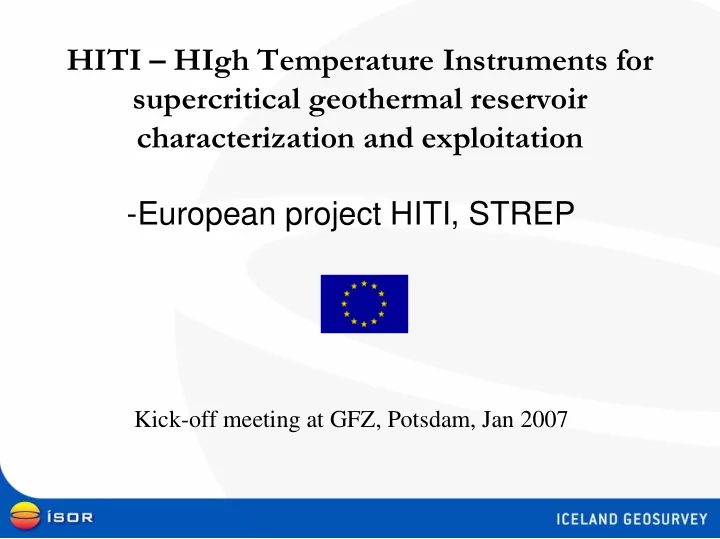

HITI – HIgh Temperature Instruments for supercritical geothermal reservoir characterization and exploitation -European project HITI, STREP Kick-off meeting at GFZ, Potsdam, Jan 2007
HITI and IDDP The main objective of the HITI project is to develop sensors and methods to accurately determine the existing conditions of the reservoir and fluids in-situ at the base of a deep geothermal system in Iceland HITI
Partners HIgh Temperature Instruments for supercritical geothermal reservoir characterization and exploitation 1 ÍSOR Iceland 2 CNRS Montpellier France 3 BRGM France 4 Calidus Engineering Ltd. U.K 5 ALT, Luxembourg 6 Oxford Applied Technology U.K. 7 GFZ-Potsdam Germany 8 CRES Greece Submitted in Dec. 2004 HITI
Main objectives Developing downhole instruments capable of tolerating temperatures over 300 °C, and preferably up to 500 °C . • develop and field test downhole instruments and methods tolerating temperatures above current limits. These instruments include: temperature, pressure, fluid and rock electrical resistivity, natural gamma radiation, televiewer acoustic images, pH, casing collar locator, casing monitoring, fluid flow, chemical temperature sensing and organic tracers, • adapt an existing HPHT (High Pressure, High Temperature) laboratory facility to the measurement of electrical resistivity at appropriate reservoir conditions and varying fluid nature, • validate the new instruments from the analysis of downhole data and samples (either core or fluid) from field tests in either hot existing wells, or the new IDDP hole. HITI
Tool/method deliverables 1. MultiSensor, PLT400, 400°C 2. High temperature wireline T sensor 3. Gamma ray (GR) detector, 300 °C 4. Dual Laterolog (DLL), 300 °C 5. Televiewer with casing thickness evaluation to 300°C and cement monitoring 6. Distributed temperature sensing 7. HPHT rig 600°C laboratory 8. Na-Li temperature evaluation to 500°C 9. Organic tracers to 350°C HITI
Complete oxide isolation of all transistors TiW barrier layer on all metals and contacts Variable width oxide trench Twin well technology CrSi thin film resistors available N+poly to N+silicon linear capacitor 0.8 micron 5 volt digital capability Designed for 50,000 hours of 225°C operation Final test at 225°C ambient Burn-in at 250°C HITI
400°C Memory tools, temperature, pressure, flow, casing collar and conductivity 350 °C Pressure / Temperature / flow Comparison: Kuster K10, 350°C (4h) HITI
The act of logging HITI
320 °C wireline temperature sensor Comparison: Kuster, 177°C, 114 MPa Comparable ISOR gauges do not exceed 140-150°C HITI
Dual Laterolog (DLL), 320 °C Resistivity logs have proven to be very useful to analyse fundamental formation properties relating to geothermal exploration. HITI
Televiewer with casing thickness evaluation to 300°C and cement quality beyond casing HITI
Diamonds replacing silicon in integrated circuits? HITI
Distributed temperature sensing, 300°C DTS: Temperature measured instantaneously and simultaniously in the whole well using laser and fibre optic cable. Groß Schönebeck°: 143°C, 4.2 km HITI
HPHT 600°C laboratory Measure electrical resistivity at 600 °C, 200 MPa and varying fluid nature. HITI
Organic tracers to 350°C and Li analysis To estimate the reservoir temperature from chemical analyses performed on fluid samples collected either in-situ or at surface. Isotopic Li analyses, performed by ICP-MS/MC on high temperature fluid samples for the first time, are proposed to ameliorate the knowledge of this geothermometer and to confirm the nature of the reservoir rocks in contact with the geothermal fluid. To use organic compounds (sulfonate naphthalene family) to carry out tracer tests in high temperature geothermal wells (up to 350°C) in order to detect possible hydraulic connections between wells and to estimate the reservoir capacity (storativity) and the fluid flow rate. HITI
Status: In force..... • EU funding is 2.5M€ • Project kicks off in January 2007: NOW • Opportunity for the geothermal exploration industry and research communities, e.g. high- temperature electronics, geosciences, instrument design and measuring techniques HITI
Recommend
More recommend